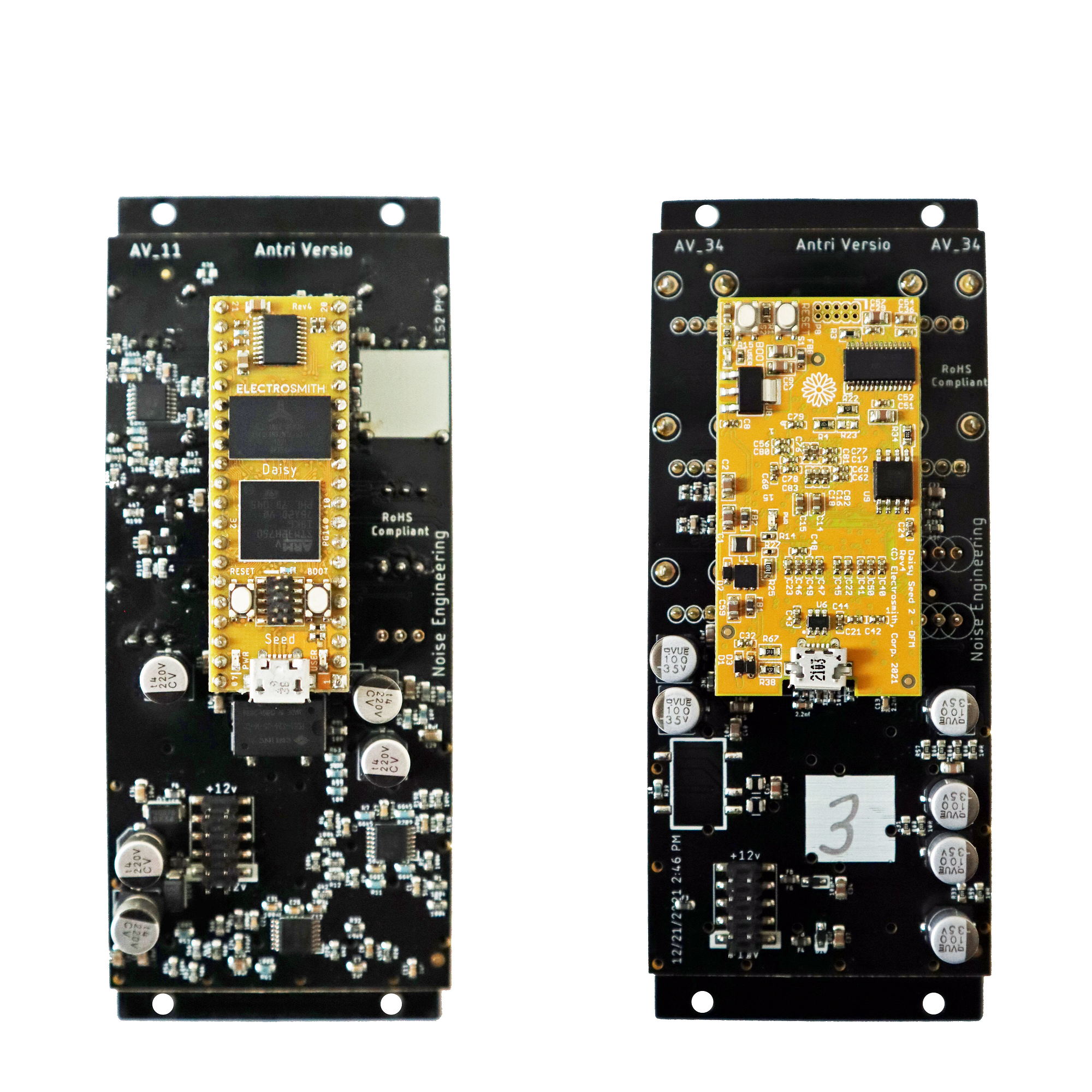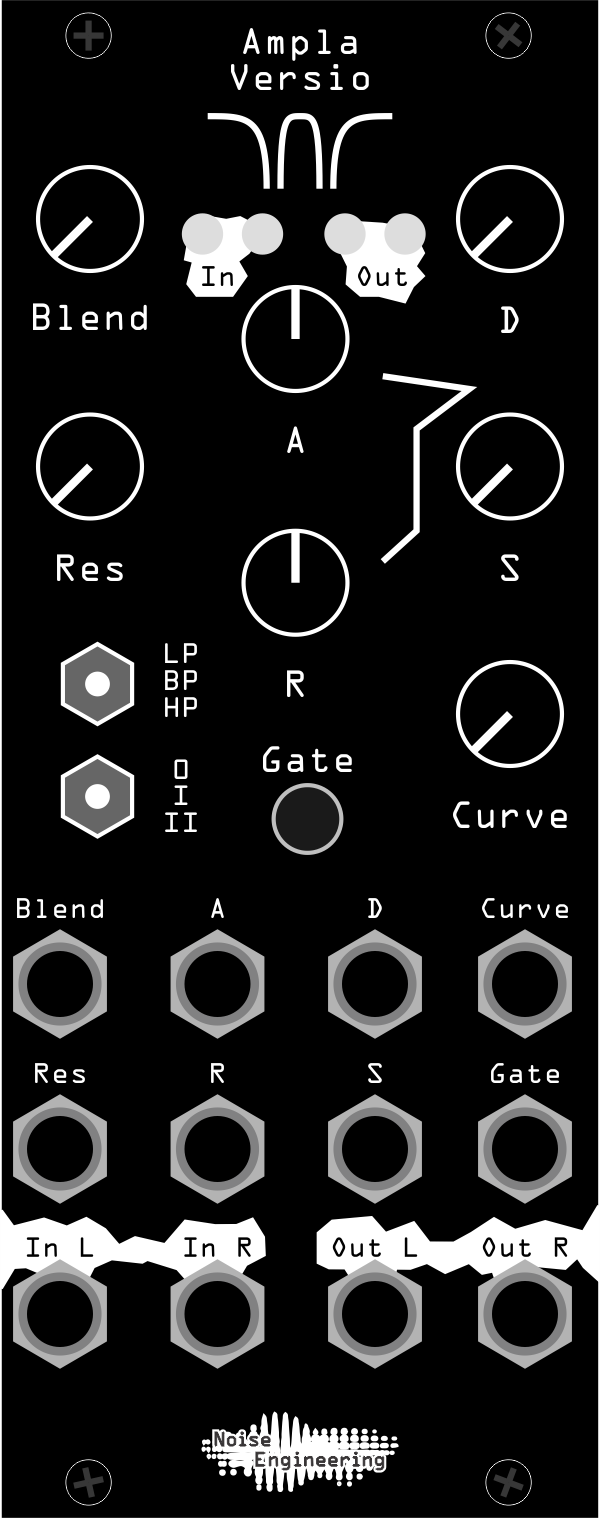Ampla Versio Manual#
ADSR-controlled stereo VCA/MMF gate and chorus
Overview#
Ampla Versio is an ADSR-controlled VCA and resonant multimode-filter gate, with a stereo bypassable chorus on top. The firmware offers a number of different dynamic and tone-shaping options: the Blend control fades between a pure VCA and a VCA/filter combo, behaving similarly to a traditional lowpass gate, but with lowpass, bandpass, and highpass filter settings. The ADSR envelope is fully voltage controllable and also features a dynamic curve control, creating an expressive envelope you can shape to your liking.
- Type: Envelope/VCA/MMFgate/chorus
- Size: 10 HP
- Depth: 1.5 inches
Etymology#
Ampla -- from Latin: "Amplify"
Versio -- from Latin: "Versatile"
"Versatile amplification"
Color code#
On boot, the Versio's LEDs will shine with this color pattern to indicate that it is running the current Ampla Versio firmware:
Power#

To power your Versio, turn off your case. Plug one end of your ribbon cable into your power board so that the red stripe on the ribbon cable is aligned to the side that says -12 V and each pin on the power header is plugged into the connector on the ribbon. Make sure no pins are overhanging the connector! If they are, unplug it and realign.
Line up the red stripe on the ribbon cable so that it matches the white stripe and/or -12 V indication on the board and plug in the connector.
Screw your module into your case before powering on the module. You risk bumping the module's PCB against something metallic and damaging it if it's not properly secured when powered on.
If your Versio looks like the left picture, it requires 70mA +12v and 70mA -12v. If it looks
like the right picture, it requires 125mA +12v and 10mA -12v. Versio does not use the
+5v rail.

You should be good to go if you followed these instructions. Now go make some noise!
Input & output voltages#
All CV inputs expect 0 V to 5 V. All pots act as offsets and sum with the input CV. The Gate input responds to signals above +2 V. The audio inputs clip around 16 V peak to peak.
Interface#

Presented here are the parameter names followed (in parentheses) by the names of those parameters on Desmodus Versio for easy tweaking.
- Blend (Blend)
- Mixes between a pure VCA and a VCA/filter combo.
- Res (Speed)
- Filter resonance
- A (Tone)
- Attack time
- D (Regen)
- Decay time
- S (Size)
- Sustain level
- R (Index)
- Release time
- Curve (Dense)
- Envelope curve control, curving the envelope from logarithmic to linear to exponential
- Gate (ESU)
- Gate input (button functions as a manual gate)
- LP/BP/HP (LIM/DST/SHM)
- Changes the filter type of the MMF gate side between lowpass, bandpass, and highpass
- 0/I/II (BND/LRP/JMP)
- Chorus control (none, some, max)
- In L/In R
- Audio input. If R is not patched, the signal from L is normaled to both inputs.
- Out L/Out R
- Stereo output pair
Patch tutorial#
Start with the Blend parameter fully counterclockwise, and the 0/I/II switch in the left position. Patch an audio source to the L input (if your source is stereo patch to the R input as well). Patch the L/R outputs to your mixer. Patch a gate sequencer or keyboard gate output to the Gate input and tweak the A/D/S/R parameters to create an envelope shape that suits your style.
Next, turn Blend fully clockwise and try out the LP/BP/HP filter settings to shape your sound harmonically as well as dynamically.
Finally, flip the 0/I/II switch to the I or II position to add some chorus and width to your sound.
As on the Desmodus Versio, all non-switch parameters are CV controllable. Try mapping a CV channel of your sequencer, or a velocity or mod wheel output from a controller to the Blend parameter to give your sound an extra layer of tonal variation.
Firmware swapping#
Use our firmware swap app to change your platform module's firmware at any time.
To get started:
- Turn off the power to your case and unscrew the module.
- Remove the power connector on the back of the module.
- Plug a micro USB connector into the port on the pack of the module, and the other end into your computer.
- Follow the instructions in the firmware swap app.
Design notes#
The allure of being able to do alternate firmwares when we designed the Desmodus was strong. At writing, we have a firmware for almost every letter of the alphabet (we refer to things internally by their initials). The VCA/x-pass gate was something we were interested in but we didn't know how much development we wanted to put into it as hardware. Once we agreed that it could work as an alt firmware, it was a no-brainer.
The firmware started budding during NAMM 2020 when Stephen stayed home for a few days and, with zero interruptions except the dogs (don't underestimate how disruptive they can be), he got a first pass on three or four firmwares. They had a long way to go (and some still do…, but some are coming soon!). With everything that is 2020, a lot was delayed this year and so the initial release of the Desmodus took a lot longer than we'd hoped. But that's well covered territory. We finished this firmware and considered releasing it but then thought it seemed like a nice present for our customers.
We don't plan to print a panel for this one, but if you're interested in trying out all the firmwares and want a blank panel we'll have those available (as replacement panels or as an option when you purchase). International friends, we'll make them available to retailers too so it's easier for you to pick them up. Want to just print the overlays? Grab the files on our site here. Want to create your own? The panel file is available on our website here if you want to make your own, too.
Warranty#
We will repair or replace (at our discretion) any product that we manufactured as long as we are in business and are able to get the parts to do so. We aim to support modules that have been discontinued for as long as possible. This warranty does not apply to normal wear and tear, including art/panel wear, or any products that have been modified, abused, or misused. Our warranty is limited to manufacturing defects.
Warranty repairs/replacements are free. Repairs due to user modification or other damage are charged at an affordable rate. Customers are responsible for the cost of shipping to Noise Engineering for repair.
All returns must be coordinated through Noise Engineering; returns without a Return Authorization will be refused and returned to sender.
Please contact us if you think one of your modules needs a repair.
Special thanks#
- René Boscio
- Erwin Coumans
- Rob Vonderheide